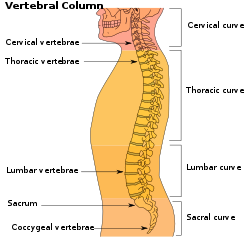| Coccyx | |
|---|---|
 The coccyx | |
 The coccyx is the final bone in the vertebral column that surrounds the spinal cord. | |
| Details | |
| Pronunciation | /ˈkɒksɪks/ KOK-siks |
| Identifiers | |
| Latin | os coccygis |
| MeSH | D003050 |
| TA98 | A02.2.06.001 |
| TA2 | 1092 |
| FMA | 20229 |
| Anatomical terms of bone | |
The coccyx (pl.: coccyges or coccyxes), commonly referred to as the tailbone, is the final segment of the vertebral column in all apes,[1] and analogous structures in certain other mammals such as horses. In tailless primates (e.g. humans and other great apes) since Nacholapithecus (a Miocene hominoid),[2][3] the coccyx is the remnant of a vestigial tail. In animals with bony tails, it is known as tailhead or dock, in bird anatomy as tailfan. It comprises three to five separate or fused coccygeal vertebrae below the sacrum, attached to the sacrum by a fibrocartilaginous joint, the sacrococcygeal symphysis, which permits limited movement between the sacrum and the coccyx.
- ^ Weisberger, Mindy (March 23, 2024). "Why don't humans have tails? Scientists find answers in an unlikely place". CNN. Archived from the original on March 24, 2024. Retrieved March 24, 2024.
- ^ Nakatsukasa 2004, Acquisition of bipedalism (See Fig. 5 entitled First coccygeal/caudal vertebra in short-tailed or tailless primates..)
- ^ Note: Nacholapithecus and Nakaliphitecus nakayamai are two different species of Miocene hominoids (specimens from Nakali and Nachola respectively). See for example "Comparisons with Other Hominoids" in (Kunimatsu, Nakatsukasa et al. Dec 2007)